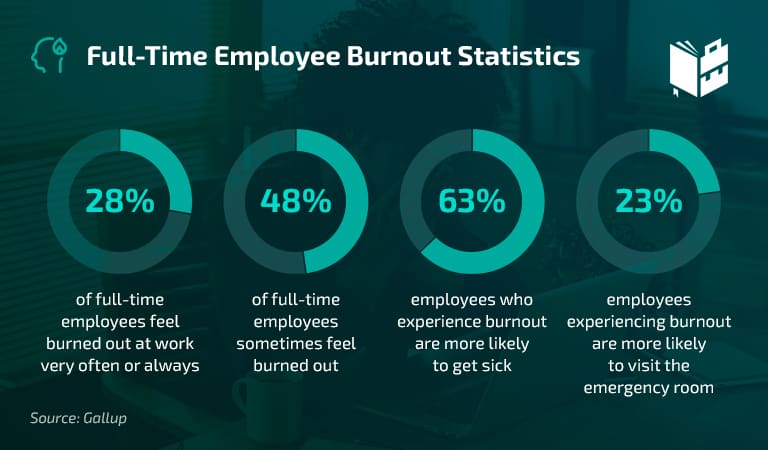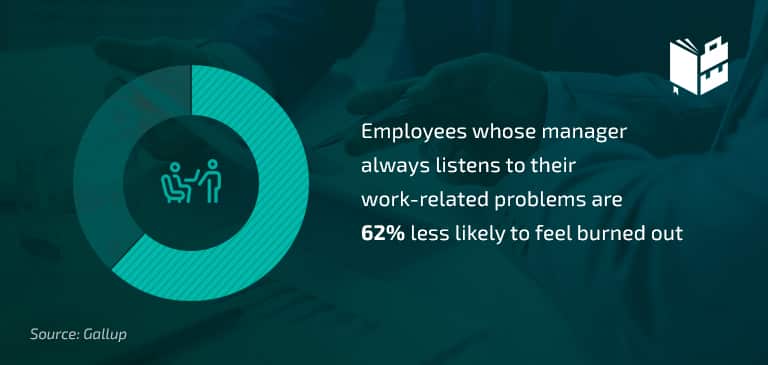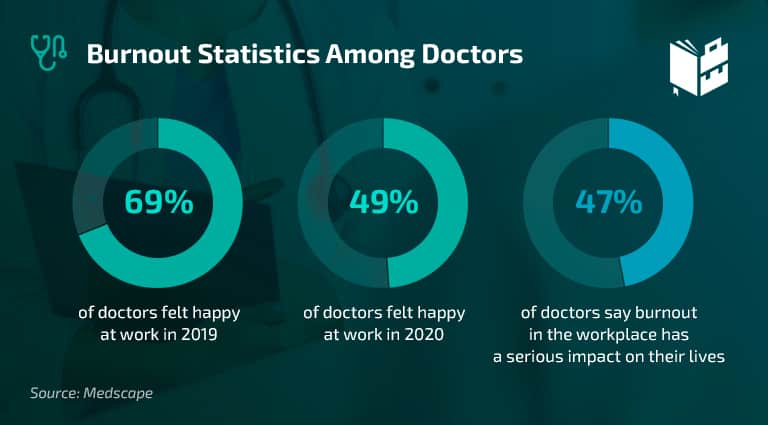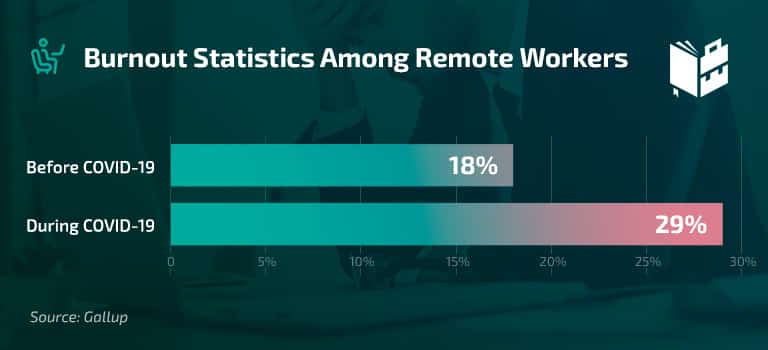Employee burnout statistics indicate that chronic stress at work often results in mental health problems, regardless of the job type. According to the WHO, lack of recognition, unfair treatment, and overworking can result in employee burnout.
Employee well-being equals business well-being. Better awareness of the signs and reasons for employee burnout can help managers identify and address these issues before they become too big to handle.
These 30 statistics will give a clear picture of employee burnout, why it happens, and what you can do about it in your workplace environment.
Job Burnout Statistics (Editor’s Choice)
- 84% of millennials have experienced burnout at their current job.
- 21% of employees feel burned out every day.
- 60% of emergency medicine physicians are burned out.
- 1% of physicians have attempted suicide due to burnout at work.
- 29% of remote workers experience burnout at work very often.
- 11.23% of nurses in the world have burnout symptoms.
- Job burnout affects the personal lives of 83% of employees.
- Working for more than 50 hours a week increases burnout risks.
- Employees are 70% less likely to develop high burnout symptoms when they have enough time to complete tasks.
Stats for Employee Burnout in the Workplace
Employees across industries show different symptoms of burnout, ranging from minor dissatisfaction to career disappointment. Based on extensive research in the field, the overall condition of workers depends on many factors.
It turns out that the level of seniority often dictates the burnout level. Managers are more likely to develop burnout symptoms than regular employees, qualifying managerial positions as one of the top jobs with high burnout rates.
1. 28% of full-time employees say they feel burned out at work very often or always.
(Gallup)
A recent Gallup study of nearly 7,500 full-time employees found that 48% of them sometimes feel burned out. That’s nearly eight in ten full-time employees experiencing job burnout at least some of the time.
Workplace burnout also causes psychosomatic symptoms. This explains why employees who habitually experience burnout are 63% more likely to call in sick and 23% more likely to visit the emergency room.

2. Statistics on employee burnout claim that 73% of millennial employees are less productive due to job burnout.
(Zapier)
Known as workaholics, millennials and Gen Zers tend to experience job burnout more than the previous generations. A study has shown that jobs are essential parts of the personal identity of both generations. This attitude, paired with their work ethic of being ‘always on,’ puts them at a higher risk of employee burnout.
These employee burnout statistics additionally showed that 85% of millennial employees think a mental health policy should be implemented at their workplace, and most Gen Zers agree (91%).
3. Employees who have the opportunity to do what they do best are 57% less likely to experience burnout frequently.
(Gallup)
Diversity in the workplace is a good thing. When employees’ strengths and weaknesses are recognized, and tasks are assigned accordingly, they become less stressed, according to recent employee burnout data.
Above all, their productivity and efficiency levels rise because employees feel empowered. Knowing that they are valued as individuals prompts employees’ satisfaction and contributes to a positive environment in the workplace.
4. Employees are 2.3 times more likely to experience high levels of workplace burnout if they face mistreatment.
(Gallup)
According to the EEOC, discrimination in the workplace is a major factor contributing to burnout. While it’s written in most policies that discrimination based on race, religion, gender, age, origin, disability, or gender is illegal in the workplace, this type of aggression still persists in many offices around the globe.
Burnout statistics by profession disclose that the degree of unfair treatment at work varies by industry, but abusive management or inconsistent policies negatively affect every workplace equally. Over time, the endurance of this type of behavior results in feeling disrespected and leads to burnout.
5. The risk of occupational burnout increases greatly when employees exceed 50 hours per week.
(Gallup)
Research has shown overworked employees are prone to experiencing burnout very often or always. Overwork can be defined as working too many hours or being assigned too many tasks.
Conversely, statistics about employee burnout show that highly engaged employees work more hours per week but do not report burnout symptoms indicating that employee engagement and job flexibility add to employees’ well-being.
6. Employees whose manager always listens to their work-related problems are 62% less likely to feel burned out.
(Gallup)
An integral responsibility of managers is to provide two-way communication, allowing employees to express frustrations about work-related issues. Employees who feel that they can confide in their manager have lower chances of developing burnout symptoms and feel that they are appreciated. Employee burnout statistics reiterate that creating a respectful environment promotes the wellness and satisfaction of employees in the workplace.

7. Employees who have a space that helps them connect with coworkers have a less than 26% chance of frequent burnout.
(Gallup)
A pleasant working space with convenient means of communication and enough room for everybody not only creates a team environment but contributes to employees feeling connected and supported at work. For example, isolation is a serious contributing factor to burnout, as employees who are isolated often feel unsupported, unseen, and unheard by the company.
8. The stats for employee burnout in the workplace say that 32% of managers report feeling burned out at work very often or always.
(Gallup)
Taking care of employees’ welfare is one of the manager’s main responsibilities, but managers regularly find themselves as a go-between for the executive’s orders and employees’ concerns. Managing multiple expectations without proper support or decision-making power is a leading cause of manager burnout.
9. 21% of employees experience the effects of burnout daily.
(Emplify)
Emplify’s new report on employee engagement reveals worrying rates of employee burnout. An incredible 62% of employees reported experiencing burnout at work, and 32% of those employees experienced burnout every single week.
10. 30% of employees are burned out because of unrealistic expectations.
(Deloitte)
Deloitte’s study shows that 87% of their respondents have a passion for their current job. An alarming 64% of them, however, feel frequently stressed at work. The lack of support or recognition from leadership (31%) and consistently working long hours or on weekends (29%) were two chief reasons for burnout.
Physician Burnout Statistics
Working in healthcare is not an easy job. Physicians are responsible for every admitted person’s life in every specialty, which contributes to a high-stress environment. For physicians, dealing with burnout is a constant challenge that negatively affects patient care, their happiness, and personal relationships.
Unfortunately, workplace burnout among physicians often leads to depression and even attempts of suicide. According to healthcare burnout statistics, medical intervention, coupled with a leave of absence until recovered, is the only solution in severe physician burnout cases.
11. 47% of physicians think they are burned out.
(Medscape)
According to a survey conducted in 2022, the employee burnout rate among physicians reached a critical level. These numbers reflect the heavy impact of the coronavirus pandemic on healthcare systems and workers across the globe. The rate of employee burnout is higher in some specialties than in others, however, such as critical care and emergency medicine.
12. Emergency medicine is the highest-ranking specialty, with a 60% burnout rate.
(Medscape)
Considering current events, emergency medicine is the highest stressed sector of healthcare right now, but critical care isn’t far behind, with just a 4% difference in burnout rates. Obstetrics and gynecology ranked third with 53%, and the lowest was public health and preventive medicine with 26%.
In comparison, the top three burnout rates by specialty for the year before coronavirus were critical care (51%), rheumatology (50%), and infectious diseases (49%).
13. Female physicians experience job burnout more than male physicians.
(PubMed)
According to gender discrimination in the workplace statistics, female physicians report emotional exhaustion due to gender discrimination in the workplace. This goes further than experiencing discrimination from other employees but from patients as well, creating a work environment that is full of repetitive stressors.
Additionally, Medscape’s statistics on burnout at work for female physicians show that it has been higher than for males for years. This indicates an institutional issue within the field of medicine that female doctors face throughout their careers.
14. 60% of physicians list bureaucratic tasks as the top cause of burnout.
(Medscape)
The same data shows that 39% of physicians said that a lack of respect from coworkers and employers is the reason for feeling burned out, while 34% cited long hours as the main cause.
Interestingly, only 10% of the physicians selected stress from treating COVID-19 patients as the largest contributor to their burnout, indicating that heavy bureaucratic responsibilities are an industry stressor.
15. Burnout rates by profession show that workplace burnout impacts the lives of 54% of physicians severely.
(Medscape)
There are many impacts of physician burnout. From considering changing professions even after years of medical training, developing mental health issues such as anxiety, chronic frustration, and PTSD to poor social relationships and family problems, many physicians fail to address the chronic stress they experience in their industry.
The latest data states that many doctors have trouble getting up in the morning, with just 47% reporting that they feel happy at work as opposed to 68% before the pandemic.

16. Most recent overworked employees statistics suggest that 48% of physicians exercise to cope with job burnout syndrome.
(Medscape)
The benefits of being physically active are numerous, even in cases of mental health problems. Fortunately, a large number of physicians are taking advantage of their own knowledge. Still, 35% also report that they eat junk food to feel better, and 24% use alcohol as a source of relaxation.
17. 39% of doctors think a more manageable work schedule would reduce their burnout symptoms.
(Medscape)
Busy schedules seem to cause higher rates of employee burnout in healthcare. However, a significant number of physicians also think that financial stress adds to their condition. The average pay of a primary care physician in the US is $260,000 per year, according to the latest data.
Before the COVID-19 crisis, primary care physicians’ average annual salary was $243,000, while specialists earned $346,000 per year on average.
18. 24% of physicians suffer from clinical depression due to employee burnout.
(Medscape)
The newest available employee burnout statistics indicate that physicians experience many stress-related symptoms, such as hair loss, weight gain, insomnia, inability to de-stress, and feelings of hopelessness. Most respondents reported that workplace burnout is the root cause of their depression.
Another 64% of the physicians describe their state as colloquial depression, meaning they often feel sad but don’t have other, more serious signs of burnout. Despite the graveness of the doctors themselves, 53% of physicians said that they don’t let depression caused by burnout affect their interaction with patients.
19. The highest burnout rate for jobs statistics reveal that 1% of physicians have attempted suicide due to burnout at work.
(Medscape)
Clinical depression not only affects the quality of life of those who experience it but can also lead to more serious consequences. Medscape’s survey reveals that while 9% of doctors never attempted suicide, they reported thinking about it.
In particular, pathologists had the most prevalence of suicidal thoughts (13%), more than the other specialties. Needless to say, the profession of a physician is not one of the jobs with low burnout rates unless you’re working in the public health and preventive medicine sector.
20. 41% of physicians state that their workplace doesn’t offer a program to reduce stress and/or burnout.
(Medscape)
There are techniques proven to reduce employee burnout. Well-planned programs and policies that give workers manageable workloads and access to time off when they need it are all ways in which employers can prevent burnout.
Unfortunately, many workplaces don’t enforce these programs, and hospitals and clinics are no exception. With long hours and incredible performance expectations, 17% of physicians don’t even know whether their workplace has a burnout prevention program that they can join.
Statistics on Nurse Burnout
Nurses are on the front line of healthcare. With heavy caseloads, extensive administrative duties, and often short-staffed hospitals, the stress of nursing is well-documented.
The healthcare institution relies heavily on the well-being of nurses to perform their jobs with high efficiency as they perform most of the routine tasks and care-related work. Especially since the onset of a global pandemic, nurses are in high demand. Employee burnout statistics show that nursing is one of the most stressful occupations across the globe.
21. 11.23% of nurses in the world have burnout symptoms.
(PubMed)
One large study on the well-being of nurses surveyed 45,539 nurses across multiple specialties and 49 countries about job burnout. According to the data, the highest burnout symptoms rate was in the Sub-Saharan African region, while Europe and Central Asia reported the lowest. In terms of specialties, pediatric nurses had the highest burnout symptom rates, while geriatric care nurses had the lowest.
22. 25.3% of primary care nurses feel burned out.
(ScienceDirect)
In one study of employee burnout statistics, one-fourth of a sample of 396 nurses reported having burnout systems due to environmental factors such as unfavorable working conditions. Poor conditions actively contribute to the fact that nurses feel burned out, while environments full of support, resources, and good relations with coworkers decrease the likelihood of burnout by 51%–58%.
23. 70% of oncology nurses and nurse assistants are at medium to high risk of burnout.
(Medscape)
Due to the nature of this specialty, oncology nurses are particularly vulnerable to burnout. According to overworked employees statistics, 45% of them are experiencing depersonalization, and 55% don’t feel fulfilled.
Emotional difficulties that oncology nurses encounter daily are a primary contributing factor to burnout rates in this sector. The oncology culture, however, is another factor that deeply affects their well-being.
The desire to prove oneself is very strong due to expectations of prestige in this field, and because of it, nurses often deny the first signs of emotional exhaustion. Based on job satisfaction statistics, this results in a chain reaction ending in increased absenteeism, difficulties with colleagues, and job dissatisfaction.
24. Healthcare burnout statistics indicate that COVID-19 is driving the drop in the career satisfaction of one-third of nurses.
(Medscape)
Up until 2020, around 90% of nurses and APRNs were satisfied with their career choice. Nowadays, only 11–23% of them have expressed career satisfaction, with some variance based on specialty.
Clinical nurse specialists reported the highest increase in job satisfaction (23%) and the lowest decrease in job dissatisfaction (25%). In addition, certified registered nurse anesthetists had the lowest job satisfaction increase (11%), while nurse midwives’ job dissatisfaction growth was the highest (41%).
25. Job burnout statistics say 17% of registered and licensed practical nurses experience high levels of burnout.
(Medscape)
According to the latest Medscape report, RNs and LPNs endure the highest levels of burnout among all nurses. Nurse midwives (NMs) are right behind, with 16% reporting the same levels of burnout. On the other hand, 21% of certified registered nurse anesthetists (CRNAs) and 22% of clinical nurse specialists (CNSs) say they aren’t feeling burned out at all.
Employee Burnout Statistics 2022
The latest available burnout statistics have shown that the pandemic spared no profession. Research across industries and occupations reveals unmanaged work-related stress is taking its toll on employees’ mental health. While businesses can’t control the extraneous factors of COVID-19, the existing data suggests that companies can do more to improve employee experience.
26. 29% of remote workers are experiencing burnout at work very often or always.
(Gallup)
Only 18% of people working from home had burnout symptoms in the pre-pandemic period. Now, statistics on burnout at work indicate that remote work isn’t considered a job perk anymore. With almost one-third of remote workers feeling burnt out most of the time, many report feeling isolated and that work is a burden.

27. 62% of the people struggling to manage their workloads have experienced burnout often or extremely often in the previous three months.
(HBR)
Workplace statistics clearly show that almost two-thirds of employees are severely disconnected from their work after months of intense burnout. The survey also emphasized that rising cynicism among the surveyed employees was a serious consequence of burnout.
Job burnout statistics place millennials among the top burned-out employees due to feelings of loneliness, lower seniority, and having little autonomy at work.
28. 83% of respondents say burnout from work can negatively impact their personal relationships.
(Deloitte)
It seems work-related issues don’t just stay at the office, uncontrollably spilling over into other aspects of one’s life. An incredibly high percentage of employees feel that burnout has no boundaries. New statistics on employee burnout suggest unmanageable amounts of stress negatively affect the work and lives of 91% of employees.
29. 84% of millennials say they have experienced burnout at their current job.
(Deloitte)
Millennials tend to feel the weight of their job more than other generations. In this survey, the majority of millennials say they have had burnout symptoms at one time or another. This is directly contrasted to other generations, with only 77% of respondents experiencing burnout. However, even though millennials are more inclined to do something about it, nearly 50% report leaving a job because they feel burned out.
30. Job burnout statistics tell us employees are 70% less likely to develop high burnout symptoms when they have enough time to complete tasks.
(Gallup)
The latest data specifies that tight deadlines and pressure to perform at a certain speed provoke feelings of mild to severe anxiety. Surmounting tasks instigate more pressure, which causes anxiety that eventually leads to burnout. While this can be a technique for companies to try and increase productivity, the final result is that employees miss work or stop working altogether, costing the company more money and bigger delays.
Employee Burnout Statistics — Conclusion
Occupational burnout is an ever-present issue that affects employees of all ages, professions, industries, and genders. Companies need to provide employees with positive and supportive working environments to ensure the well-being of their workers and increase productivity at the same time.
The newest job statistics warn us that the effects of workplace burnout can have long-term consequences on employees’ mental and physical health. An exhausted workforce will, in turn, cost companies much more than investing in their welfare in the first place.